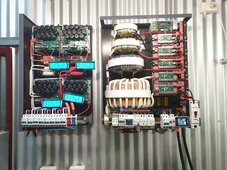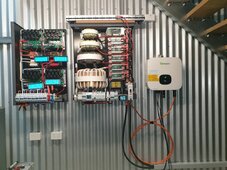timselectric
If I can do it, you can do it.
- Joined
- Feb 5, 2022
- Messages
- 19,304
Who makes an 18k?
You should probably learn what products you currently offer before thinking about what could be next.That exist on the 18k
I fixed it boss you are correctYou should probably learn what products you currently offer before thinking about what could be next.
Sounds like a midnite b17.Speaking of modular, what about a modular AIO where you pick the size components you need. Kinda like a “build your own AIO”. You select the size inverter, mppt, etc. If you decide down the road you need a larger component, you just upgrade that individual piece. Kinda goes along with the “user serviceability” that @42OhmsPA mentioned.
Don’t the LLs do this and wall mounts?Improve the BMS on the eg4 batteries to allow for 2A balancing like the jks can do. So owners don't have to deal with potentially many cycles and holding at full charge for days/weeks which may not be possible in a mobile situation to get them to properly balance.
I've never seen the LLs advertised as having a higher balancing current than the lifepower4s. Should prob be better publicized if that's the case to get the upsell.Don’t the LLs do this and wall mounts?
That’s coming or is already in placeCanadian distributors


Who built this I’m amazedHere’s some of the things I wanted in an inverter and you guys have mentioned a number of them as well.
The idea of having all the switch gear inside the inverter was attractive to keep it simple and neat … and avoid lots of interconnected boxes on the wall ... and the bare minimum of external wiring.
And having a modular design to make any servicing quicker and easier. You can change a module over in this inside 10 minutes and several of them are interchangeable. So this could be user serviceable. Unfortunately I haven’t built a batch of spare modules yet, but the bits are here.
And of course it’s so big there’s no room for charge controllers or mppts … so they all fit in a separate box … or they will when the box is finished. That was something else I wanted because most of us need multiple mppts … so why not put them and the switching into one unit.
These are easily serviceable and can be unscrewed and removed in probably 5 minutes … while the rest remain working.
While it’s not a new idea, another feature I wanted was to be able to use the inverter to provide my own “grid” … then hook up additional grid tie inverters to add to the system … but still remain off grid. These additional GTI's will backfeed through the Warpverter to charge the battery when there is excess power.
It has gone the wrong way voltage wise though and stayed at 48V. If I could have found some Nissan Leaf batteries when I first started I may have aimed for 96 or maybe 120V. I do know a guy who built one of these to run off about 250V from a Toyota Prius … so there’s lots of possibilities.
It’s old school low frequency inverter design, so that gives it massive surge capability. This one can run up to 15kW and theoretically at least double that for surges … not that I’ve had the courage to try that yet.
I’m not planning on manufacturing these mind you, but it's nice to see that others have similar ideas.
The inverter design/circuit is not mine ... this is just my interpretation of a Warpverter.
View attachment 214406
I still need to disappear the wiring for the Growatt.
View attachment 214407


